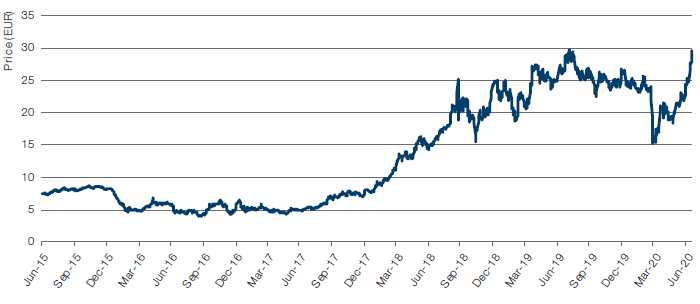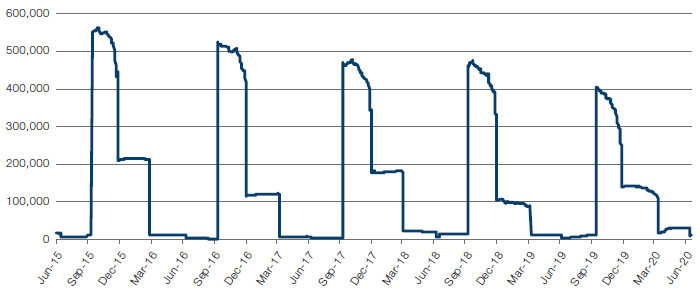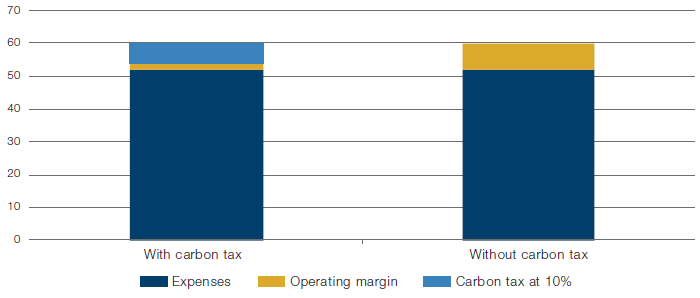Introduction
What is the net present value of the Earth?
No, seriously – how much would you pay for the use of the Earth and its resources? How could you accurately value the only known planet capable of supporting life itself?
Those who work in financial markets have long accepted that almost everything has a price. Yet when it comes to the cost of pollution and climate change, we believe not enough people are discussing how we start to charge companies and consumers for the use of our most precious resource – the planet.
Carbon emissions are what is known as an ‘externality’: firms that emit carbon place a burden on the environment which is borne by everyone in the form of a changing climate, yet don’t incur a cost for doing so. Carbon pricing is an attempt to put a price on the emission of carbon into the atmosphere, to redress the balance by introducing a cost for this most important externality. In this article, we outline the main types of carbon pricing, discuss their limitations and sketch a rough vision of how we believe carbon taxes should be applied.
Methods of Carbon Pricing
There are two main methods of carbon pricing.
The first is an Emissions Trading Systems (‘ETS’), also referred to as a cap-and-trade system. This is where a regulator sets a cap on the total amount of greenhouse gas emissions, and allocate a specific number of allowances to various businesses. Low-emitting businesses with excess allowances can then sell these to high-emitting firms. Within the cap, overall greenhouse emissions can be reduced, whilst simultaneously being cognisant to the fact that different businesses have differing levels of carbon intensity. It also allows for the key element of price discovery within the cap: instead of a price being pulled out of thin air, the value of carbon emissions can be discovered through trading.
The biggest current ETS is operated by the EU, accounting for roughly 75% of the world’s carbon trading.1 The scheme covers carbon-dioxide (‘CO2’) emissions from industrial, power and aviation companies, alongside nitrogen-dioxide (‘NO2’) emissions from some sectors of the chemicals industry and perfluorocarbon (‘PFC’) emissions from primary aluminium production. As part of a reform package agreed in 2018, emission allowances will decrease by 2.2% annually, instead of the previous figure of 1.74%.2
However, ETS are not a panacea. The price discovery element is a poor representation of the economic value of a tonne of emissions, as trading takes place in conditions of artificial scarcity. It took some time for prices to actually move within the EU ETS, with volatility only observed from 2017 onwards (Figure 1).
Figure 1. Price of Permit to Emit One Tonne of CO2 Equivalent

Source: Bloomberg; as of 7 July 2020.
Indeed, the price is still not high enough: a report by the Carbon Pricing Leadership Coalition suggested that prices needed to be between USD40-80 per tonne of CO2 emissions (‘tCO2e’) in 2020 and USD50-100 per tCO2e by 2030 to remain on track to achieve the Paris Agreement temperature target of below 2 degrees Celsius.3 In this respect, there is some way to go.
In addition, liquidity in the EU ETS is poor, with spikes in trading volume observed during the fourth quarter of every year (Figure 2). Similar to other commodity markets, the role of outright speculators in price discovery is unclear: it is possible for anyone to trade the contracts within the EU ETS.
This latter fear is something which the coronacrisis has thrown into stark illumination. Between 19 February and 18 March, the carbon price on the EU ETS has fallen by about 40%. Indeed, things got so bad that on 18 March, the European Energy Exchange (‘EEX’) was forced to cancel an ETS auction due to a paucity of bids. In our view, the collapse was precipitated by three factors. First, the collapse in airline activity had removed a major source of demand for allowances. At the same time, some industrial companies were selling their permits to raise capital to see them through the global demand slump. Third and most importantly (and with long-term implications for the functioning of the market), the general economic climate caused speculators to liquidate their carbon positions to generate cash needed elsewhere in their portfolios. This sucked capital out of the ETS, sparking a price collapse at a time when there are precious few bidders in sight. Whilst the price has since recovered, the plunge raises questions about the overall resilience of cap-and-trade systems.
Figure 2. Spikes in Trading Volume on the EU ETS

Source: Bloomberg; as of 7 July 2020.
A further critique is that a cap does not in itself reduce carbon emissions. To do so, we would need to gradually reduce the total supply of allowances (as the EU ETS does), thus guaranteeing price increases. To an extent, this undermines the purpose of an ETS by making rationing – rather than trading – a much bigger factor in price discovery. If we wish to decarbonise the economy, creating a prohibitive carbon price through scarcity could therefore be considered useful, but would undermine claims that a market solution could be found to solve the problem. This is not a criticism in terms of how ETS function, but provides food for thought for those who would argue that there should be a market solution to the climate change problem. Ultimately, markets operate on supply and demand, but because scarcity isn’t a factor in carbon markets (as emissions are an externality not a commodity), it should be no surprise that trading takes place in a somewhat artificial way.
The other main method of introducing a cost to emissions is via carbon taxes. The underlying concept is fairly simple: a government tax on the emission of carbon, or a tax on products and activities which cause carbon emissions.
Regionally, implementation has differed widely. France currently operates a flat carbon tax of EUR45 per tCO2e on industrial, building and transport emissions. In contrast, the UK operates a carbon price floor, which is the difference of a centrally chosen carbon tax of GBP18 per tCO2e and the EU ETS price per tCO2e.
Despite their different methodology, both achieve the same goal of setting a price for carbon emissions, and putting a cost on an externality.
Gilet Jaunes, Regulatory Arbitrage and Scope: The Challenges of Carbon Pricing
As with ETS schemes, carbon taxes have their flaws. As a tax on consumption rather than income, they are inherently regressive. Just as a hike in VAT costs more as a percentage of disposable income for those on lower wages, so too does a carbon price. Companies which have to pay tax on their carbon emissions are faced with two choices – pass on the cost to consumers, or cut their own margins. This can be no choice at all, and companies will usually pass on the cost to consumers as far as possible.
For example, take a hypothetical budget airline company. If it charges GBP60 per ticket, with an operating margin of 13.2%, a 10% carbon tax applied to the face value of the ticket would absorb some 76% of operating profit (Figure 3). We might say that low-cost flights should not be available if we wish to save the planet, and applaud if the price hike reduces flying. However, the effect of major industries such as airlines becoming unprofitable is significant: in a worst-case scenario, new employment must be found for thousands of employees, in the best case, consumers are directly impacted.
Figure 3. Theoretical Effect of Carbon Price on Airline Margins

Source: Man Group, for illustrative purposes only.
The gilets jaunes movement in France exemplifies the problems the application of carbon taxes can cause. Tax on diesel and petrol rose 7.6 and 3.9 cents per litre, respectively, in France in 2018, with a further hike of 6.5 cents and 2.9 cents planned for 1 January, 2019.4 In response, protests erupted across France, forcing President Emmanuel Macron to cancel the 2019 hike and commit to a wider reform package. Politicians can find themselves in a catch-22 situation, caught between the vociferous demands of their political base, and the urgent need to take practical steps to combat climate change.
The lack of a universal carbon price also fuels the problem of regulatory arbitrage. Without a universal pricing mechanism, firms would be able to list in jurisdictions with less stringent carbon pricing, to reduce the cost of emission on their global operations. In some ways, this is similar to tax regimes. And bringing geographies associated with tax optimisation to book is easier said than done. It does not take a particularly cynical mind to imagine that countries might apply the same logic to carbon pricing.
Attempts are being made to address this issue, mostly notably by the EU’s proposed Carbon Border Adjustment Mechanism. The overall aim is to mitigate the likelihood that the EU does not achieve its binding 2050 target of carbon neutrality, irrespective of whether other nations pursue climate friendly policies. Although the exact details of the proposal are yet to be finalised, itis likely to take one of three forms: 1) a carbon tax on various selected products, covering both domestic and imported goods; 2) a new carbon customs duty or tax on imports; or 3) the extension of the EU ETS to imports. Again, this does not provide a panacea, with both China and the US threatening to impose tariffs on EU exports in retaliation.5 Like tax, it is likely that attempts to bludgeon the world into compliance with carbon pricing may prove more complicated than anticipated.
Finally, there is the thorny question of how carbon pricing should apply to all three forms of emissions: Scope 1, 2 and 3. Scope 1 emissions covers direct emissions from owned or controlled sources, Scope 2 purchased emissions from electricity, heat and cooling consumption, and Scope 3 all other emissions in the company’s value chain. Scope 3 is the most controversial. If included, it would force companies to be responsible for emissions over which they have no control at all. This might seem reasonable in an effort to prevent firms from pushing emissions further up the value chain. It would, for instance, force a fashion company to be responsible for the emissions produced by its cotton suppliers, which seems an entirely reasonable proposition. However, consider the position of a bank if it was charged for Scope 3 emissions. It would be difficult to claim that a bank who underwrote an oil firm’s bonds does not have oil emissions in its value chain – after all, it is the prospect of selling oil that pays the underwriting fee. But banks would then be responsible for the emissions of their entire customer base, which would be prohibitive. If carbon pricing was limited to Scope 1 and 2, that same bank would be able to pay very little in carbon tax, even though it could theoretically be financing a huge amount of carbon emissions.
Where Do We Go From Here?
Whilst imperfect, carbon pricing mechanisms do solve the key problem: they make it costly for firms to emit carbon into the atmosphere, and provide a disincentive for polluting business models.
In our view, three steps are required to make implementation of carbon pricing more effective. Firstly, we need to establish a global carbon price, applying at the very least to Scope 1 and 2 emissions, under the auspices of a global authoritative body such as the UN.
Secondly, and most importantly, this development needs to be backed by a concerted political effort to deal with climate change at the top of the agenda – politicians need to sell the importance of climate change to the electorate. There is no point implementing climate-friendly policies if, like Macron’s fuel tax, they have to be sacrificed on the altar of political expediency. To do this, governments need to plan for the transition away from fossil fuels, making provision for compensation and re-training for those whose industries are negatively affected, and need to use the revenue raised to mitigate the fact that carbon prices disproportionately affect those on low incomes.
Last but not least, there needs to be in place vigorous methods to combat and punish attempts by companies that avoid and and/or minimise their carbon tax, without countries attempting to gain market share by undercutting global standards.
Conclusion
Three steps are required to make implementation of carbon pricing more effective, in our view: a global carbon price, backed by concerted political effort to drive climate change and methods to combat and punish attempts by companies that avoid and and/or minimise their carbon tax, without countries attempting to gain market share by undercutting global standards. With this 3-pronged approach, carbon pricing can be what it needs to be: a disincentive and a check on both supply and demand that makes it less attractive to consume carbon-intensive products.
As carbon pricing actualises a financial impact from emissions, we hope to see companies increasing their use of a range of counter-measures, from accelerating use of renewable energy to zero-carbon product innovation to voluntary offsets. The challenge of decarbonisation is undoubtedly a huge mountain to climb, but by working together, we believe all stakeholders from the general public to corporates to policymakers can contribute to achieving the crucial goals of the Paris Agreement.
1. Source: European Commission; EU Emissions Trading System.
2. Source: World Bank Pricing Dashboard.
3. Report of the High Level Commission on Carbon Prices, 29 May 2017.
4. Source: BBC; France Fuel Unrest: ‘Shame’ on Violent Protestors, Says Macron; 25 November 2018.
5. Source: FT; US threatens retaliation against EU over carbon tax, 26 January 2020.
You are now leaving Man Group’s website
You are leaving Man Group’s website and entering a third-party website that is not controlled, maintained, or monitored by Man Group. Man Group is not responsible for the content or availability of the third-party website. By leaving Man Group’s website, you will be subject to the third-party website’s terms, policies and/or notices, including those related to privacy and security, as applicable.